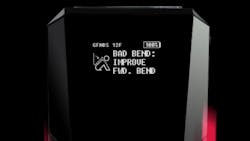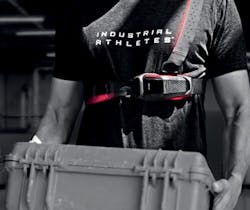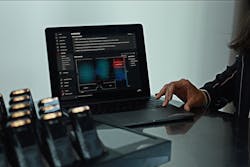The article below was initially published in March 2020. Since that time, StrongArm Technologies has configured its Fuse device for use in ensuring social distancing as well. Read more about that at the end of the article.
As safe as industrial production has become over the past few decades through machine and process safety advances and even collaborative robotic technologies that now extend to industrial robots, risks to worker safety still exist. And as new connected technologies advance through industry, workers are becoming increasingly mobile, meaning that individual risks to safety are constantly changing as personnel move around a facility.
The application of connected sensors to gather equipment data as part of Industry 4.0 and Industrial Internet of Things (IIoT) initiatives is now being applied to industrial workers to improve their safety. An example of this is StrongArm Technologies’ Fuse sensor and platform—an industrial grade, lightweight IoT device designed to capture a worker’s movement data. Worn by the worker, the sensor takes readings 12.5x per second, which translates to around 300,000 times during an eight-hour shift.
Weighing less than two ounces, the Fuse sensor contains a 9-axis IMU (inertial measurement unit) which reportedly provides accurate readings on five main components which make up a user’s safety score. Those components are derived from Dr. William Marras’s Lumbar Motion Monitor Risk Model: average maximum flexion, average twist velocity, average maximum lateral velocity; lift rate; and maximum moment.
Data collected by each Fuse device uploads to the cloud, where the Fuse platform’s proprietary machine learning algorithm analyzes the wearer’s risk of musculoskeletal injuries.
Explaining the sensor technology behind Fuse, Michael Kim, CTO and co-founder of StrongArm Technologies, said the Fuse sensor is a singular device with multiple integrated sensors. “Under the hood of the Fuse sensor there is a complex circuit board that we have designed to be compact, user friendly, and durable,” he said.
In terms of how data captured by the Fuse sensor translates into corrective measures for workers, Kim said the data allows us to “really take an in-depth look at various trends and anomalies in the data. Using the core features of our platform’s dashboard, we’re able to understand where behavioral improvements like training and real-time feedback are applicable. We’re also able to identify areas that require improvement and show where engineering controls or physical constraints may need to be implemented.”
As an example of how Fuse sensor data can be applied, Kim referenced work StrongArm Technologies has done with a large retailer in its distribution center. “We were seeing a consistently low safety score in a specific area in the warehouse. After analysis and discussions with the customer, we came to understand that there was an environmental constraint that didn’t allow for proper safe behaviors. In response, they modified the work environment.”
Insights gained by StrongArm Technologies from its Fuse deployments are being collected into a “growing library of options with demonstrated improvements across our customer profiles that might be applicable to others,” Kim said.
Since its initial release in 2017, StrongArm Technologies claims Fuse has seen more than 100 installations (seven of which are at Fortune 100 businesses) and received the Best Invention Award from Time in 2018.
The big change that Kim sees Fuse bringing to industry is in how worker safety assessments are done. “Current ergonomic and safety assessments are usually done with a piece of paper, some cameras, tape measures, and visual observation—usually with a highly trained ergonomist or safety professional,” he said. “As you can imagine there are a couple of issues with this approach:
1) You can only observe so many people within a given time frame; and
2) The nature of the observation will introduce some sort of change in the work being done, known as the "Hawthorne Effect.”
Speaking to what StrongArm Technologies has learned about Fuse through its installations to date, Kim said the immediate tangible benefit for users is injury reduction. “At the scale that we have been able to work with customers, we have repeatedly provided actual injury claims reductions of up to 50% year over year. And when you take a look at the cost of a lower back injury, which averages out to be about $60,000, according to OSHA and the Bureau of Labor Statistics—not to mention the compounding effects of lost labor hours and potential overtime and staffing to make up for missed work—the costs can stack up quickly.”
For workers concerned about the tracking potential associated with a wearable device, StrongArm Technologies says that Fuse does not track productivity, nor does StrongArm work with companies that are trying to use Fuse in any punitive way for the workers. According to StrongArm Technologies, this is a purposeful business decision, in part because the mission of the company is to protect the workers, and to focus on how data can solve that particular risk element for them.
Social Distancing Update
In May 2020, Strong Arm Technologies announced a reconfiguration of its Fuse wearable sensor technology for social distancing applications.
In this reconfiguration, the Fuse sensor uses Bluetooth to measure the distance between sensors and can provide vibration, visual, and auditory alerts when sensors get too close. Alerts begin with flashing LEDs and vibrational feedback. These alerts escalate to auditory alerts if the worker’s position is not corrected.
In addition, the platform’s data capture enables contact tracing. Proximity interactions are time-stamped and logged on Fuse sensors. Daily reporting in the platform can identify non-compliant individuals as well as identify individuals potentially at risk. Data captured by the platform provides historical contact tracing data in the event of a confirmed case or infection.
Leaders relevant to this article:




